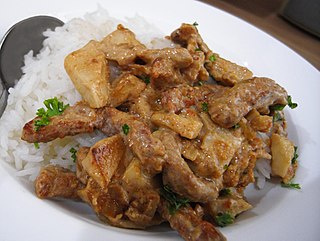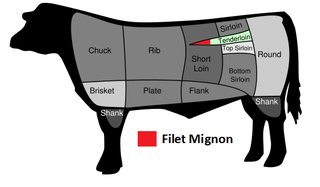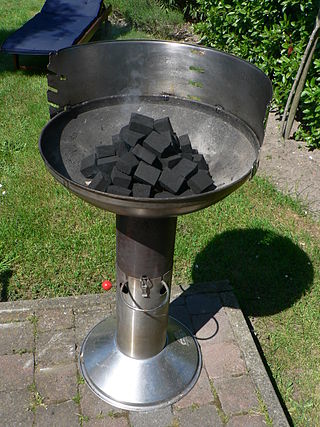
In cooking, a sauce is a liquid, cream, or semi-solid food, served on or used in preparing other foods. Most sauces are not normally consumed by themselves; they add flavor, moisture, and visual appeal to a dish. Sauce is a French word taken from the Latin salsa, meaning salted. Possibly the oldest recorded European sauce is garum, the fish sauce used by the Ancient Romans, while doubanjiang, the Chinese soy bean paste is mentioned in Rites of Zhou in the 3rd century BC.

A beefsteak, often called just steak, is a flat cut of beef with parallel faces, usually cut perpendicular to the muscle fibers. In common restaurant service a single serving has a raw mass ranging from 120 to 600 grams. Beef steaks are usually grilled, pan-fried, or broiled. The more tender cuts from the loin and rib are cooked quickly, using dry heat, and served whole. Less tender cuts from the chuck or round are cooked with moist heat or are mechanically tenderized.

Goulash is a soup or stew of meat and vegetables seasoned with paprika and other spices. Originating in Hungary, goulash is a common meal predominantly eaten in Central Europe but also in other parts of Europe. It is one of the national dishes of Hungary and a symbol of the country.

Meatloaf is a dish of ground meat that has been combined with other ingredients and formed into the shape of a loaf, then baked or smoked. The final shape is either hand-formed on a baking tray, or pan-formed by cooking it in a loaf pan. It is usually made with ground beef, although ground lamb, pork, veal, venison, poultry, and seafood are also used, sometimes in combination. Vegetarian adaptations of meatloaf may use imitation meat or pulses.

Chateaubriand is a dish that traditionally consists of a large front cut fillet of tenderloin grilled between two lesser pieces of meat that are discarded after cooking. While the term originally referred to the preparation of the dish, Auguste Escoffier named the specific front cut of the tenderloin the Chateaubriand.

Beef Stroganoff or Beef Stroganov is a Russian dish of sautéed pieces of beef in a sauce of mustard and smetana. From its origins in mid-19th-century Russia, it has become popular around the world, with considerable variation from the original recipe. Mushrooms are common in many variants.

Filet mignon is a cut of meat taken from the smaller end of the tenderloin, or psoas major of a cow. In French, it mostly refers to cuts of pork tenderloin.

Barbecue varies by the type of meat, sauce, rub, or other flavorings used, the point in barbecuing at which they are added, the role smoke plays, the equipment and fuel used, cooking temperature, and cooking time.

Steak au poivre or pepper steak is a French dish that consists of a steak, traditionally a filet mignon, coated with coarsely cracked peppercorns. The peppercorns form a crust on the steak when cooked and provide a pungent counterpoint to the beef. Steak au poivre may be found in traditional French restaurants in most urban areas.

Mushroom sauce is a white or brown sauce prepared using mushrooms as its primary ingredient. It can be prepared in different styles using various ingredients, and is used to top a variety of foods.

A steak is a thick cut of meat generally sliced across the muscle fibers, sometimes including a bone. It is normally grilled or fried. Steak can be diced, cooked in sauce, such as in steak and kidney pie, or minced and formed into patties, such as hamburgers.

Coffee sauce is a culinary sauce that includes coffee in its preparation. It is sometimes prepared using instant coffee. Coffee sauce has been used in American cuisine since at least 1904. Coffee sauce may be sweet or savory.

Onion gravy is a type of gravy prepared with onion. Various types of onions are used in its preparation. Some preparations caramelize the onions. Onion gravy may be served to accompany many foods, such as pork, beef steak, meatloaf, hamburger, bangers and mash, hot dogs, and French fries, among others. Vegan onion gravy also exists, which may use seitan cooking broth in its preparation. Premade mixes and formulations also exist, such as solid sauce bars.

Wine sauce is a culinary sauce prepared with wine as a primary ingredient, heated and mixed with stock, butter, herbs, spices, onions, garlic and other ingredients. Several types of wines may be used, including red wine, white wine and port wine. Some versions are prepared using a reduction. Several types of wine sauces exist, and it is used in many dishes, including those prepared with seafood, poultry and beef. Wine sauces are associated with French cuisine.

Beurre maître d'hôtel, also referred to as maître d'hôtel butter, is a type of compound butter of French origin, prepared with butter, parsley, lemon juice, salt and pepper. It is a savory butter that is used on meats such as steak, fish, vegetables and other foods. It may be used in place of a sauce, and can significantly enhance a dish's flavor. Some variations with a sweet flavor exist. It is usually served cold as sliced disks on foods, and is sometimes served as a side condiment.

Sautéed mushrooms is a flavorful dish prepared by sautéing edible mushrooms. It is served as a side dish, used as an ingredient in dishes such as coq au vin and beef bourguignon, in foods such as duxelles, as a topping for steaks and toast, and also as a garnish.

Garlic sauce is a sauce prepared using garlic as a primary ingredient. It is typically a pungent sauce, with the depth of garlic flavor determined by the amount of garlic used. The garlic is typically crushed or finely diced. Simple garlic sauce is composed of garlic and another ingredient to suspend the bulb via emulsion, such as oil, butter or mayonnaise. Various additional ingredients can be used to prepare the sauce.


















